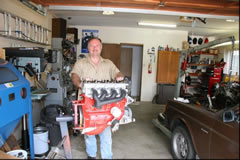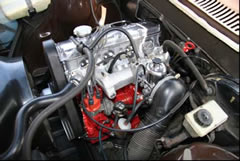Building the World’s Most Powerful Single Carburetor Volvo Engine
August, 2007
The title is perhaps a bit self-aggrandizing but for years I have thought about building a powerful Volvo OHC engine, using twin SU carburetors on it instead of the more traditional K-Jet or single SU or Stromberg . I was able to find an example of every intake manifold Volvo built for the B21-23 engines to determine if a twin SU flange could be welded to it to accept a pair of my favourite carbs. I looked carefully at the LH, K-jet and turbo manifolds. None were water heated, and the turbo runners were very small. The LH has a tortuous path, suitable for air, but not fuel-air. The K-jet runner angles were incorrect for a horizontal carb set-up. The single carb manifolds are water heated, which prevents easy modification to twin carbs. I discovered as well that the Stromberg manifolds have tiny runners and the SU manifolds have large runners like the K-jet intakes. My only option was to use the early single SU manifold, and a single SU HIF6.
I rationalized this in two ways. First, NASCAR uses restrictor plates that have a very small cross-sectional area, and they pull 600 odd horsepower through them. The 1 ¾ bore of an HIF6 would be positively huge to a NASCAR engine builder. Second, the old hot rod techniques of displacement, compression ratio, and camshaft, would compensate for the single carb. A modified B23E engine saddled with an HIF6 would have to do.
I found a 1981 B23E in good running condition. When I dismantled it however, two pistons were scuffed, and the front intermediate shaft bearing was fatigued and disintegrating. The crankshaft was perfect, as was the oil pump. I also had to find an intermediate shaft that had the fuel pump eccentric fully machined – many of the E and F engines use a shaft with the eccentric in an “as cast” condition, which would chew up the pump lever quite quickly.
I had a couple of good B23E pistons of the same series in stock. I found the correct intermediate shaft, and installed a high pressure relief valve spring in the original oil pump. I purchased piston rings for a B23F – the same part apparently, and I was told that I had purchased the last set in Canada. New intermediate shaft bearing were located – again I was told that they were the last set in Canada- and installed. I honed the cylinders myself with an expanding hone and then did a quick plateau finish using a ball hone. What little ridge was present in the bores was removed – about .0015 inch increase was all it took. Stock main and rod bearings completed the parts.
I used an electronic scale to weigh the rods and pistons. By swapping them amongst themselves I achieved a set of four assemblies within 4 grams of each other without any metal removal. I didn’t bother with the crank. I lightened the flywheel in a lathe, removing about four pounds of iron from the rim, and had it balanced too.
The cylinder head was in fine shape, with no electrolysis damage around the water passageways. The head was surfaced on a state of the art broach which produced a near mirror finish. I carefully blended the intake and exhaust ports into the valve inserts. Compared to the iron B20 heads the B21-23 heads are cast far more accurately, and very little aluminum had to be removed. I did a small amount of profiling at the start of the intake port to ensure a good transition from the manifold. The valve seats received a three angle cut, and the intake seats were moved as high as possible on the intake valve face. I then cut a 30 degree back cut on the valve to aid airflow over the otherwise sharp edge. All of the valve guides were in excellent shape, so new seals and a quick valve adjustment completed the head, using the original K camshaft.
The intake manifold was another matter. The B21A SU manifold has a very sharp transition from the short runner from the carburetor flange into the log between the cylinder runners. There are numerous casting bumps and roughly machined surfaces intersecting each other. I spent a great deal of time blending these. The last few inches of each runner were also blended to provide a good transition in the head. I did not increase the cross sectional area at all.
The carburetor was rebuilt – no surprise there – but included a few extra touches, one of which was the removal of the deceleration valve in the throttle plate. I have removed hundreds of these over the years. As the throttle blade opens the spring is progressively lowered into the fuel discharge from the main jet, and my theory is that this promotes fuel separation and disrupts distribution, particularly in the single carb applications. I can’t back this up with any scientific data, but every engine I have done this to has responded with better throttle response and smoother part throttle operation.
I decided to stick with the original B21A distributor. That engine uses breaker points which I like for simplicity and reliability. However in the B21 the distributor is set to 12 degrees BTDC and the B23E electronic distributor is set to 5 degrees. The advance curves are quite different. As well I had disconnected the vacuum retard side of the module on the B21A distributor, intending to only use the vacuum advance. On the stock engine this produced a part throttle ping on 88 octane. Just what would happen running 12 degrees initial on the B23 with 10:1 compression I didn’t yet want to think about.
The engine swap took about six hours total. It fired up on the first turn of the key, and settled down to an idle which I describe as one half of a Z-28 Camaro. There is no doubt that the engine has a big cam, lots of compression, and a light flywheel.
The engine needed a bit more fuel right away, so the needle in the carb took several trips to the drill press for thinning. I also had to compensate for the cold air induction. I use the stock air filter box, but do not use the heated air source from the exhaust manifold. The engine gets air from the grill year round. That produced leanness on the stock engine, and certainly contributed some to the new set-up.
Running 94 octane I can use 12 BTDC, and have never heard a ping out of it. In the summer I would pull the choke out to fire it up, and then push it in all the way once the engine was running. I could then just drive away with only a hint of leanness. I have also been able to start the engine without the choke from overnight cold, and this ability has me completely confused. The old engine would not start or drive without a lot of choke for several minutes. This one doesn’t need the choke except when very cold. I have been telling people for years that SU carbs need to be richened to get any engine started from cold – and this one has now proven me wrong.
This “hybrid” engine pulls hard to 6500 RPM in the first three gears. Air resistance keeps fourth to around 5500. I have run it to 7000 in first and second, and interestingly it has a distinct induction “whoop” when running that fast. It is very smooth at all RPM’s. With the big cam and the SU it likes to idle at 1100 as any lower and the Z-28 shake gets quite pronounced. I can climb 8% grades in fourth at 1800 RPM – lots of bottom end torque – so the engine is not “fussy”. On the highway at 3800 cruising I can get nearly 30 MPG, and in town about 21-23. And in town I thrash it mercilessly. It is difficult to estimate horsepower – and I can therefore only offer a guess – perhaps 140, about what a good B23E makes. It is a long way from the B21A’s 95 horsepower though. As well the engine is in the Brown Bomber, a 1980 242DL, which is about 200 pounds lighter than the GLT the B23E came from. In any event it is a lot more powerful than I thought it would be. And I can think a lot of power!
It seems the alternator has had enough though – its bearings are beginning to squeak a bit in the morning. I can’t imagine why…..


